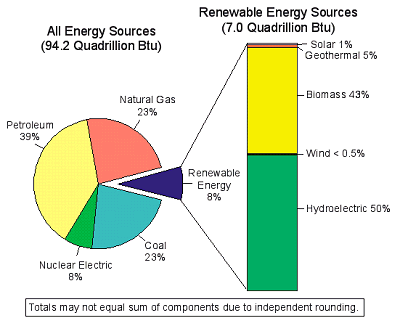Renewable energy resources are:
- Hydro*
- Solar (includes solar thermal
and photovoltaic)
- Wind
- Tidal
- Biomass (wood, wood waste, wood
sludge, municipal solid waste, ethanol, peat, agricultural waste, straw,
tires, landfill gases, fish oils)
- Geothermal
*Hydropower is often considered
a “conventional” energy source because it has provided a significant amount
of electricity for more than a century.
|
U.S.
Energy Consumption by Source, 1998
|
|

|
|
Sources:
Energy Information Administration (EIA), Annual Energy Review 1998,
DOE/EIA-0384(98) (Washington, DC, July 1999), Table 1.3. 1998 Renewable
Energy: Consumption values based on the sum of electricity consumption
from EIA, Electric Power Annual 1998, Volume II, DOE/EIA-0348(98)/2
(Washington, DC, December 1999), and non-electricity consumption based
on analysis by the Office of Coal, Nuclear, Electric and Alternate Fuels.
|
Renewable energy consumption declined 4 percent between 1997
and 1998 to 7 quadrillion Btu, accounting for almost 8 percent of total U.S.
energy consumption. Hydroelectric power and biomass continued to dominate
the renewable energy market, with 50 percent and 43 percent shares, respectively.
Most of the decline was due to a drop
in consumption for hydroelectric power. Despite the decline in overall renewable
energy consumption, geothermal and biomass energy consumption increased in
1998. Excluding hydroelectric power, renewable energy consumption (including
net imports of geothermal energy) rose 2.2 percent in 1998.
|
Table H1. U.S. Renewable Energy Consumption by Energy Source, 1994-1998
(Quadrillion Btu)
|
|
Energy Source
|
1994
|
1995
|
1996
|
1997
|
1998
|
|
Conventional Hydroelectric Power a
|
R2.971
|
R3.474
|
R3.913
|
R3.922
|
3.540
|
|
Geothermal Energy b
|
0.395
|
0.339
|
0.352
|
R0.328
|
0.334
|
|
Biomass c
|
R2.917
|
R3.048
|
R3.108
|
R2.981
|
3.052
|
|
Solar Energy d
|
0.072
|
0.073
|
0.075
|
0.074
|
0.074
|
|
Wind Energy
|
0.036
|
0.033
|
0.035
|
R0.034
|
0.031
|
|
Total Renewable Energy
|
R6.390
|
R6.968
|
R7.483
|
R7.339
|
7.032
|
|
a Hydroelectricity generated by pumped
storage is not included in renewable energy.
b Includes grid-connected electricity, geothermal heat pump
and direct use energy.
c Includes wood, wood waste, peat, wood sludge, municipal
solid waste, agricultural waste, straw, tires, landfill gases, fish
oils, and/or other waste.
d Includes solar thermal and photovoltaic.
R = Revised data.
Notes: See Appendix B, "Renewable Data Limitations," for a
detailed explanation of data issues. Totals may not equal sum of components
due to independent rounding.
Sources: 1994-1996: Energy Information Administration
(EIA), Annual Energy Review 1998, DOE/EIA-0384(98) (Washington,
DC, July 1999), Table 1.3. 1997 and 1998: Consumption
values based on the sum of electricity consumption from EIA, Electric
Power Annual 1998, Volume II, DOE/EIA-0348(97)/2 (Washington, DC,
December 1999), and non-electricity consumption based on analysis by
the Office of Coal, Nuclear, Electric and Alternate Fuels.
|
Although generation from wind declined
to its lowest level since 1992, wind electricity capacity rose 7.5 percent
in 1998. This reflects the beginning of a sizable increase in wind energy
projects which became commercial largely in 1999.
Although biomass energy consumption
rose overall in 1998, consumption for electricity declined, while consumption
for non-electric applications (mainly industrial process heat) rose. Industrial
biomass energy consumption has risen each year since 1991, reflecting its
position as a by-product of paper and forest product industry products.
Consumption of renewable energy
for electricity generation dropped 8 percent in 1998, while renewable generating
capacity held steady at its 1998 level, declining only 0.3 percent.
The five leading States for renewable
electricity generation are: Washington, California, Oregon, New York, and
Alabama. These States have considerable hydroelectric generation. Combined,
they accounted for 60 percent of renewable electricity generated and sold
in the United States in 1998.
|
Table 5. U.S. Electric Generating Capacity, 1994-1998
(Megawatts)
|
|
Source
|
1994
|
1995
|
1996
|
1997
|
1998
|
|
Hydroelectric a
|
78,042
|
78,563
|
R76,437
|
R79,788
|
79,573
|
|
Geothermal
|
3,006
|
2,968
|
2,893
|
2,853
|
2,917
|
|
Biomass
|
R10,468
|
R10,283
|
R10,560
|
R10,538
|
10,269
|
|
Solar/Photovoltaic
|
333
|
333
|
333
|
334
|
365
|
|
Wind
|
1,745
|
b 1,731
|
1,678
|
R1,579
|
1,698
|
|
Total Renewables
|
R93,594
|
R93,877
|
R91,900
|
R95,093
|
94,822
|
|
Nonrenewables c
|
R670,420
|
R675,640
|
R683,972
|
R683,409
|
681,062
|
|
Total
|
764,014
|
769,517
|
775,872
|
R778,502
|
775,884
|
|
a Excludes
pumped storage, which is included in "Nonrenewables."
b Excludes 6.6 megawatts of utility capacity and 35 megawatts
of nonutility capacity that were not captured by EIA sources.
c In addition to fossil-fired and nuclear capacity, includes
hydrogen, sulfur, batteries, chemicals, spent sulfite liquor, and hydroelectric
pumped storage.
R = Revised data.
Note: Capacity ratings for nonrenewables have been revised to reflect
estimated net summer capability rather than nameplate capacity. The
methodology for estimating net summer capability from reported nameplate
capacity is presented in Energy Information Administration, Inventory
of Electric Utility Power Plants in the United States 1999 with data
as of January 1, 1999, DOE/EIA-0095(99) (Washington, DC, November
1999), p. 271.
Sources: Energy Information Administration, Form EIA-860, "Annual
Electric Generator Report;" Form EIA-867, "Annual Nonutility
Power Producer Report.;" Form EIA-860A, "Annual Electric Generator
Report-Utility;" and Form EIA-860B, "Annual Electric Generator
Report-Nonutility."
|
Let’s take a closer look at Hydro
power. |